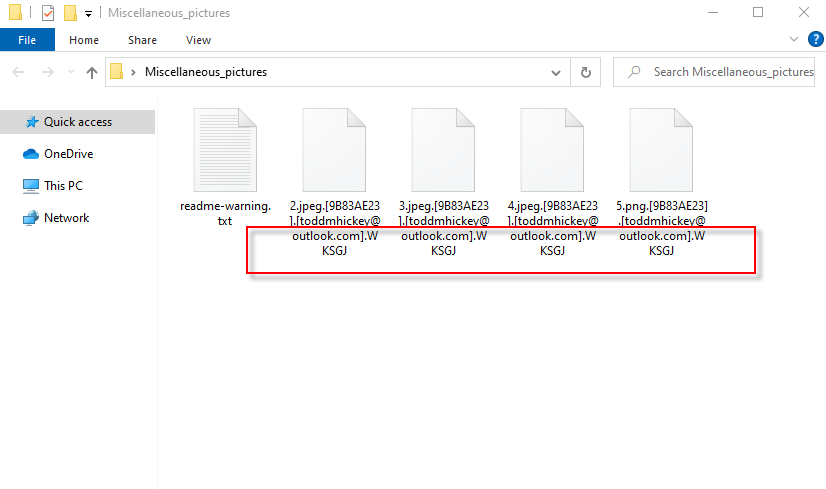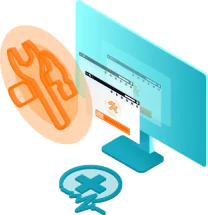WKSGJ
WKSGJ reveals its presence by generating a ransom note directly on the desktop of victim users. Usually, WKSGJ states that it has encrypted your files and you will have to pay ransom in order to get them back.

The WKSGJ Virus ransom message
This is a classic ransomware blackmail scheme that’s been around for a few decades now. And in recent years it has gained incredible momentum, with millions of new variants (Ribd, Cm99v) being released each year. WKSGJ is one such variant. Moreover, it falls in the subcategory of file-encrypting ransomware – the most dangerous subcategory of them all.
It’s true that infections of this type are no joke, and experts advise to approach them with the utmost caution. We would normally not advise to directly give into the ransom demands behind WKSGJ, for several reasons. For one, it is a lot of money, and it will, unfortunately, not guarantee that you will actually be able to use your data again. There is an array of things that could go wrong, and we’ll not get into that right now.
In addition, this will for sure just stimulate the cybercriminals to continue with their activities, as it’s a very profitable business model. What we would recommend is first tending to the removal of WKSGJ before you undertake any other actions. Below is a detailed removal guide that will show you how to do that. And once you’re done, the second part of the guide will show you what alternative file-recovery methods there are.
The WKSGJ virus
The WKSGJ virus is incredibly dangerous and very stealthy. So once the WKSGJ virus has infected your machine, there’s little to no chance that you will be able to intercept it.

The WKSGJ virus encrypted files
This is one of the factors that makes ransomware so particularly devastating and seemingly invincible even. But it’s important to understand the means by which you got infected, in order to prevent such attacks in the future. For example, one of the most common means of distribution is through so-called malvertisements.
Malvertisements are online ads that have been injected with some form of malware. And upon clicking on them, the victim user unknowingly lands an infection. Another very popular way that hackers rely on to distribute ransomware is through infected spam messages. These can be sent on any given platform and take any shape or form. But the bottom line is that there will typically be a link that you’re asked to follow or some attachment that you need to open. And that is how the virus is unleashed.
The WKSGJ file encryption
The WKSGJ file encryption is at the heart of this ransomware and it makes your files unreadable to any software. In addition, the WKSGJ file encryption is also responsible for the stealth of ransomware. Because it is not in itself a harmful act, most antivirus programs will not even be triggered by malware of this kind. This is why they have the upper hand, and this is also why it’s always most effective to prevent these attacks than be faced with their consequences.
SUMMARY:
Remove WKSGJ Virus
![]()
Some of the steps will likely require you to exit the page. Bookmark it for later reference.
Reboot in Safe Mode (use this guide if you don’t know how to do it).
![]()
WARNING! READ CAREFULLY BEFORE PROCEEDING!
*Read more details in the first ad on this page, EULA, Privacy Policy, and full terms for Free Remover.
Press CTRL + SHIFT + ESC at the same time and go to the Processes Tab. Try to determine which processes are dangerous.

Right click on each of them and select Open File Location. Then scan the files with our free online virus scanner:

After you open their folder, end the processes that are infected, then delete their folders.
Note: If you are sure something is part of the infection – delete it, even if the scanner doesn’t flag it. No anti-virus program can detect all infections.
![]()
Hold the Start Key and R – copy + paste the following and click OK:
notepad %windir%/system32/Drivers/etc/hosts
A new file will open. If you are hacked, there will be a bunch of other IPs connected to you at the bottom. Look at the image below:

If there are suspicious IPs below “Localhost” – write to us in the comments.
Type msconfig in the search field and hit enter. A window will pop-up:

Go in Startup —> Uncheck entries that have “Unknown” as Manufacturer.
- Please note that ransomware may even include a fake Manufacturer name to its process. Make sure you check out every process here is legitimate.
![]()
To remove parasite on your own, you may have to meddle with system files and registries. If you were to do this, you need to be extremely careful, because you may damage your system.
If you want to avoid the risk, we recommend downloading SpyHunter
a professional malware removal tool.
More information on SpyHunter, steps to uninstall, EULA, Threat Assessment Criteria, and Privacy Policy.
Type Regedit in the windows search field and press Enter. Once inside, press CTRL and F together and type the virus’s Name.
Search for the ransomware in your registries and delete the entries. Be extremely careful – you can damage your system if you delete entries not related to the ransomware.
Type each of the following in the Windows Search Field:
- %AppData%
- %LocalAppData%
- %ProgramData%
- %WinDir%
- %Temp%
Delete everything in Temp. The rest just check out for anything recently added. Remember to leave us a comment if you run into any trouble!
![]()
How to Decrypt WKSGJ files
We have a comprehensive (and daily updated) guide on how to decrypt your files. Check it out here.
If the guide doesn’t help, download the anti-virus program we recommended or try our free online virus scanner. Also, you can always ask us in the comments for help!




Leave a Comment